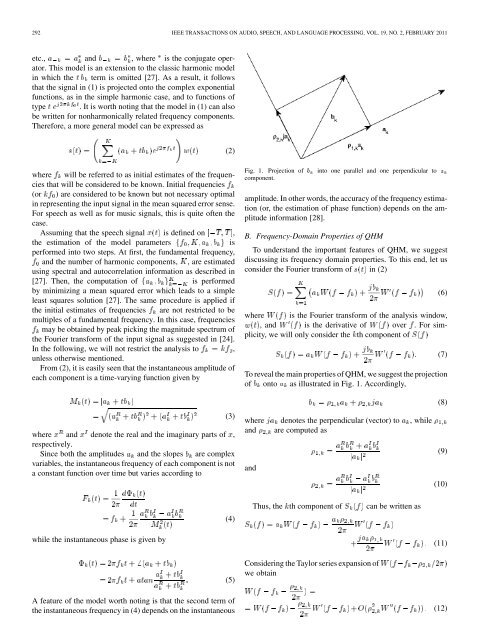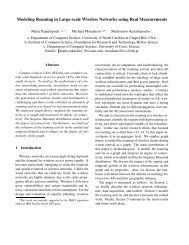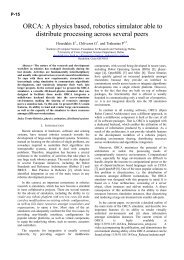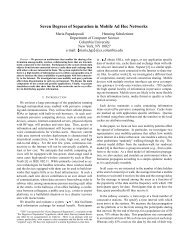Adaptive AM–FM Signal Decomposition With Application to ... - ICS
Adaptive AM–FM Signal Decomposition With Application to ... - ICS
Adaptive AM–FM Signal Decomposition With Application to ... - ICS
You also want an ePaper? Increase the reach of your titles
YUMPU automatically turns print PDFs into web optimized ePapers that Google loves.
292 IEEE TRANSACTIONS ON AUDIO, SPEECH, AND LANGUAGE PROCESSING, VOL. 19, NO. 2, FEBRUARY 2011<br />
etc., and , where is the conjugate opera<strong>to</strong>r.<br />
This model is an extension <strong>to</strong> the classic harmonic model<br />
in which the term is omitted [27]. As a result, it follows<br />
that the signal in (1) is projected on<strong>to</strong> the complex exponential<br />
functions, as in the simple harmonic case, and <strong>to</strong> functions of<br />
type . It is worth noting that the model in (1) can also<br />
be written for nonharmonically related frequency components.<br />
Therefore, a more general model can be expressed as<br />
(2)<br />
where will be referred <strong>to</strong> as initial estimates of the frequencies<br />
that will be considered <strong>to</strong> be known. Initial frequencies<br />
(or ) are considered <strong>to</strong> be known but not necessary optimal<br />
in representing the input signal in the mean squared error sense.<br />
For speech as well as for music signals, this is quite often the<br />
case.<br />
Assuming that the speech signal is defined on ,<br />
the estimation of the model parameters<br />
is<br />
performed in<strong>to</strong> two steps. At first, the fundamental frequency,<br />
and the number of harmonic components, , are estimated<br />
using spectral and au<strong>to</strong>correlation information as described in<br />
[27]. Then, the computation of is performed<br />
by minimizing a mean squared error which leads <strong>to</strong> a simple<br />
least squares solution [27]. The same procedure is applied if<br />
the initial estimates of frequencies are not restricted <strong>to</strong> be<br />
multiples of a fundamental frequency. In this case, frequencies<br />
may be obtained by peak picking the magnitude spectrum of<br />
the Fourier transform of the input signal as suggested in [24].<br />
In the following, we will not restrict the analysis <strong>to</strong> ,<br />
unless otherwise mentioned.<br />
From (2), it is easily seen that the instantaneous amplitude of<br />
each component is a time-varying function given by<br />
where and denote the real and the imaginary parts of ,<br />
respectively.<br />
Since both the amplitudes and the slopes are complex<br />
variables, the instantaneous frequency of each component is not<br />
a constant function over time but varies according <strong>to</strong><br />
while the instantaneous phase is given by<br />
A feature of the model worth noting is that the second term of<br />
the instantaneous frequency in (4) depends on the instantaneous<br />
(3)<br />
(4)<br />
(5)<br />
Fig. 1. Projection of b<br />
component.<br />
in<strong>to</strong> one parallel and one perpendicular <strong>to</strong> a<br />
amplitude. In other words, the accuracy of the frequency estimation<br />
(or, the estimation of phase function) depends on the amplitude<br />
information [28].<br />
B. Frequency-Domain Properties of QHM<br />
To understand the important features of QHM, we suggest<br />
discussing its frequency domain properties. To this end, let us<br />
consider the Fourier transform of in (2)<br />
where is the Fourier transform of the analysis window,<br />
, and is the derivative of over . For simplicity,<br />
we will only consider the th component of<br />
To reveal the main properties of QHM, we suggest the projection<br />
of on<strong>to</strong> as illustrated in Fig. 1. Accordingly,<br />
where denotes the perpendicular (vec<strong>to</strong>r) <strong>to</strong> , while<br />
and are computed as<br />
and<br />
Thus, the th component of can be written as<br />
Considering the Taylor series expansion of<br />
we obtain<br />
(6)<br />
(7)<br />
(8)<br />
(9)<br />
(10)<br />
(11)<br />
(12)
















